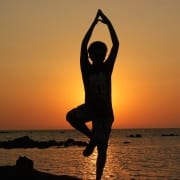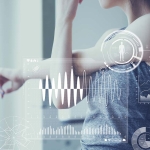Preventing & Treating Osteoporosis with Yoga, Resistance Training, Diet, & Medications
We often consider the frailty and disability associated with osteoporosis and osteopenia (bone loss that is not as severe as osteoporosis) as a normal part of aging. Medical research shows, however, that it’s not aging but inactivity that causes bones to weaken and easily break. Although medications may be necessary to treat severe osteoporotic conditions, the best preventative strategy is to engage in bone-strengthening exercises, like yoga and resistance training, and to make sure that you are getting the bone-healthy nutrition you need.
How Common Is Osteoporosis?
It is estimated that more than 53 million Americans either suffer from osteoporosis or are at high risk of developing the condition due to low bone density. In its early stages, the disease is likely to be painless or nearly painless, but as osteoporosis progresses and bones become brittle and break, the pain and disability can be severe. Many hip fractures occur when someone with osteoporosis falls. The complications associated with these fractures can require long-term nursing care or even lead to death.
In addition to osteoporosis, there are many other age-related health problems that increase one’s risk of falling, including poor balance and posture, poor vision, inner ear imbalances, a decline in proprioception (which helps us know where our body is in space), poor circulation and medications that can cause dizziness. Each of these problems, especially in combination with a decline in bone strength, increases the likelihood of fracturing a hip or vertebrae.
Additionally, research shows that bone mass is at its peak between 25-30 years old; once we hit that peak, bone rebuilding slows down and bone density can begin to decline. The earlier that you are proactive, the better, because the denser your bones are at their peak, the better the odds of postponing or even eliminating the onset of osteoporosis.
Risk Factors for Osteoporosis
The condition is usually seen in individuals over 50, but it can strike at any age, and there are factors that put you at higher risk, such as:
- Being female
- Low body weight
- Lack of physical activity
- A family history of osteoporosis
- Early menopause without hormone replacement
- Prior bone fractures
- Chronic use of steroid medications
- Smoking
- Drinking alcohol excessively
Questions? Give Us a Call!
Prevention and Treatment
Yoga:
One of the safest preventative measures and treatments for osteoporosis and osteopenia is yoga. It’s something that anyone, any age, can do anywhere; the benefits are many and risks few if done correctly.
A pretty amazing study performed by Dr. Loren Fishman, Medical Director of Manhattan Physical Medicine and Rehabilitation in New York City, showed that when individuals practiced yoga for merely 10 minutes per day over a two-year period, their bone density increased! How is this possible? In the 19th century, a German anatomist and surgeon, Julius Wolff, theorized that bone will adapt to the load which is placed on it, i.e., it becomes stronger to resist the load. The inverse is also true; as the load decreases, bone becomes weaker. This phenomenon is perhaps best demonstrated by what happens to astronauts in space, who without the force of gravity working on their bones, are at great risk for developing osteoporosis.
In holding yoga poses, tensile (stretching) force and isometric, compressive (weight-bearing) force stimulate the osteocytes (cells found in mature bone) to produce proteins and lay down new bone. Yoga produces both the stress of dynamic loading when moving into a pose and static loading by holding a pose. In addition, yoga stimulates the production of synovial fluid, which not only lubricates and nourishes the joints but also activates chondrocytes (the cells found in healthy cartilage) to lay down new cartilage. By engaging our muscles to both pull and push on the bone, yoga surpasses the bone-strengthening benefits of gravity. The benefits occur when you hold a pose for anywhere between 12 and 72 seconds. I suggest holding each pose long enough to take five to seven deep breaths (about 30 seconds).
Is “the pain worth the gain”? In his book, Yoga and Osteoporosis, Dr. Fishman quotes an ancient guru, who said, “At first, medicine can feel like heaven, but it eventually resembles poison; whereas yoga may feel like poison at first, but eventually it resembles heaven.”
Even if you already have osteoporosis, practicing yoga can be beneficial in strengthening muscle tissue and bone; however, certain joint movements should be modified or avoided altogether. Consequently, for these individuals, I highly recommend beginning with a customized, one-on-one session with a therapeutic yoga instructor.
Resistance Training:
Resistance training is a very effective tool in both maintaining and improving bone density for those who have osteoporosis or those who are at risk. Like yoga, resistance training works by applying stress to bones, stimulating the formation of new bone tissue.
As explained in this 2018 study, Effects of Resistance Exercise on Bone Health, “To stimulate the osteogenic effects for bone mass accretion, bone tissues must be exposed to mechanical load exceeding those experienced during daily living activities.” This means doing weight bearing exercises like lunges, squats or stair climbing and/or free weights, machines, or resistance band exercises at least once per week, but ideally twice (depending on your fitness level).
While there are plenty of tools online to start resistance training at home, the safest way to start is to work with a trainer. A trainer can introduce you to the safest exercises for your fitness level and create a personalized routine for you.
In addition to increasing bone tissue, resistance training also helps by increasing muscle mass which supports and protects our bones by improving balance and reducing the risk of falls, as well as improving posture and overall mobility.
A Healthy Diet:
To keep our bones strong, it’s also essential that we get enough of the following nutrients.
Vitamins:
- Vitamin C: red and green peppers, citrus fruits, broccoli, strawberries, Brussels sprouts, pineapple
- Vitamin D: fatty fishes like salmon, mackerel, tuna and sardines
- Vitamin B6: chickpeas, tuna, chicken, banana, avocados
- Vitamin B9/folate: beef liver, asparagus, Brussels sprouts, dark leafy greens, nuts, beans
- Vitamin B12: clams, oysters, beef liver, eggs, poultry
- Vitamin K: prunes, dark leafy greens
Minerals:
- Calcium: dairy products
- Magnesium: spinach, okra, tomatoes, sweet potatoes, prunes, beet greens
- Zinc: nuts, seeds, whole grains
- Manganese: whole grains, clams, oysters, mussels, nuts, legumes, coffee, tea
- Copper: cashew nuts, crab, dark chocolate, potatoes, mushrooms, oysters, beef liver
- Boron: coffee, potatoes, milk, apples, cider, legumes
- Silicon: oats, beets, barley, soy, grains
- Omega-3 fatty acids: salmon, flaxseed oil, chia seeds, walnuts, sardines, mackerel, canola oil
Nutritional Supplements:
Generally speaking, a diet rich in fruits, vegetables, mono- and poly-unsaturated fats, complex carbohydrates and lean meat (in moderation) will provide the majority of the vitamins and minerals you need. As we age, however, our individual dietary needs and our body’s ability to absorb vital nutrients may change. For this reason, if a patient’s risk factors for developing osteoporosis are high, I often recommend measuring the vitamin and mineral concentrations within his or her body so we can supplement any nutritional deficiencies.
In addition to the nutrients listed above, Strontium has recently been identified as a promising agent in promoting healthy bone maintenance. It has been labeled as a “dual-action bone agent” because of its ability to both decrease osteoclast activity (bone-destroying cells) and increase osteoblast activity (bone-forming cells). In the US, it available in the form of Strontium Citrate, and it has been found to be effective in promoting healthy bone mineralization, supporting healthy vertebrae composition and promoting healthy hip bones. Research studies have demonstrated that the supplement is well tolerated by patients and can be used as an effective alternative to osteoporosis medications.
Medications:
Bisphosphonates, such as Fosamax, Actonel, Boniva, and Reclast, are the usual “go-to” medications for treating osteoporosis because of their effectiveness in reducing osteoclast activity. Unfortunately, however, some of the medications that are used to strengthen bone can produce poor quality bone by interfering with the osteoclastic activity that cleans up dead bone. In addition, patients who take these drugs can experience unpleasant side effects, such as acid reflux, nausea, irregular bowels, musculoskeletal pain, and in rare cases, osteonecrosis of the jaw and femoral fractures. For example, Boniva as an oral or once-monthly injection can increase blood pressure, and Reclast, an annual intravenous infusion, has been associated with atrial fibrillation exacerbation (heart rhythm disorder).
There are other classes of drugs that can be used to treat osteoporosis such as selective estrogen receptor modulators like Raloxifene; and hormones, such as Miacalcin, Forteo, and Estrogens. Prolia is a monoclonal antibody medication aimed at decreasing the osteoclast (bone destroying) activity that can suppress the immune system and, in some cases, lead to serious infections, including myocarditis (infection of the heart muscle). So although there are medications available that can help reduce bone loss, in some patients their side effects may be worse than the risks of living with osteoporosis! For additional information regarding these drugs, watch: Naturally Healthy Bones: How to Prevent & Treat Osteoporosis.
How Healthy Are Your Bones?
One indication of bone health is its density, but in terms of strength, the quality of bone is even more important. Its architecture, quality of collagen, the rate of bone turnover, and the size of mineral crystal, all contribute to good bone.
Ask your physician about the painless and brief procedure called a DexaScan that uses two different strength x-ray beams to measure the thickness of a person’s hip or spine. The test results are reported as a percentage from the mean density of a healthy 25-year old (T score). Any value below -2.5% is considered osteoporosis, and any value in the range of -1% to -2.5% is considered osteopenia, which can, but doesn’t always, lead to osteoporosis. There is also a supplemental test called “Ntx” that measures collagen breakdown in the urine associated with increased bone turnover.
These test results, used in combination with other measures of your health, can give you and your doctor a good indication of your bone health and the steps you need to take to prevent or counter osteoporosis. Osteoporosis can’t be cured, but yoga and good nutrition are the best things you can do to prevent the disease or forestall its progression.
We are here for you, and we want to help.
Our goal is to return you to optimal health as soon as possible. To schedule an appointment please call: 703-532-4892 x2
This article was originally published in September 2020. It was reviewed and updated on October 14, 2024.
Additional References:
—Wolff, Julius. The Law of Bone Remodeling. Berlin: Springer-Verlag, 1986.









Leave a Reply
Want to join the discussion?Feel free to contribute!